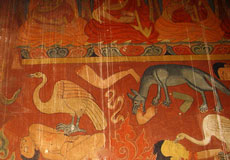Atrractions of Palkhor Monastery
Tshomchen Hall
Tshomchen, the Main Assembly Hall of Palkhor, was built between the end of fourteenth century and the beginning of the fifteenth century. The ground floor of the three-story building is a Chanting Hall with 48 columns, which are decorated with old silk "thangkas". An eight-meter high (26 feet) bronze statuary of Maitreya is also on display. The gilded figure is made from 1.4 tons (3086 pounds) of bronze. On the second floor, "Bodhisattva Manjushri" and "Arhats", from the Ming dynasty (1368-1644), were enshrined in the chapels. Its Arhat Chapel is famous throughout Tibet. On the roof, a chapel houses a collection of 15 "mandala" murals, which are three meters (ten feet) in diameter. Additionally, the monastery collects about 100 robes and costumes worn in Tibetan opera, all of which were made of silk, embroidery and tapestry during the Ming dynasty (1368-1644) and the Qing dynasty (1644-1911).
The monastery houses monks from the Gelugpa, Sakyapa and Kahdampa. Although they once quarreled and fought, the different orders eventually discovered a way to get along with each other. The monastery is the only one known to house monks from different orders in harmony. As a result, its structural style, deities enshrined and murals are very special.
Myriad Buddha Stupa
Myriad Buddha Stupa is a must in Palkhor. This Bodhi stupa covering a space of 2,200 square meters has a total of 108 gates and 77 chapels, each of which has a dominant religious figure and murals. The cylinder, 20 meters in diameter, has four chapels inside. Besides the illustrious Painting of millions Buddha, there are thousands of mud, copper and gold figures of Buddha which embrace the art style in India, Nepal and inland China. So it is called Buddha figure museum. The elegant structure is worth a visit.
Mural
The mural is also very famous. It presents various subject like two kinds of Buddhism (local and inland), Buddhism stories and the Tibetan Buddhism stories etc. Compared with the other  monasteries in Tibet, it owns unique painting skills. You can find the subject about Xiangzong on the first Sutra Hall in the big palace, cloister, the first floor of Lucky Duomen Stupa, east and west Pure Land Palace and Doushuai Palace. But the main subjects the mural in Palkhor is Mizong. If you are a tourist interested in Tibetan Mizong Buddhism, you can look for it at the Dongxi Fawang Palace, Diamond Board Palace, three story Wuliang Palace and Luck Duomen Stupa(first floor to fifth floor). The backlight is one of the most important features of Palkhor mural, composed of body and headlight. The common shape of Palkhor mural backlight is boat-shape, niche-shape and oval shape or horse foot shape. With elegant model, sufficient stripes, symmetry and bright but harmonious color, it looks extractive and sobriety, but not tarnish.
monasteries in Tibet, it owns unique painting skills. You can find the subject about Xiangzong on the first Sutra Hall in the big palace, cloister, the first floor of Lucky Duomen Stupa, east and west Pure Land Palace and Doushuai Palace. But the main subjects the mural in Palkhor is Mizong. If you are a tourist interested in Tibetan Mizong Buddhism, you can look for it at the Dongxi Fawang Palace, Diamond Board Palace, three story Wuliang Palace and Luck Duomen Stupa(first floor to fifth floor). The backlight is one of the most important features of Palkhor mural, composed of body and headlight. The common shape of Palkhor mural backlight is boat-shape, niche-shape and oval shape or horse foot shape. With elegant model, sufficient stripes, symmetry and bright but harmonious color, it looks extractive and sobriety, but not tarnish.
Saka Dawa Festival
The anniversary of Myriad Buddhas Stupa is on the 15th day of the 4th Tibetan month that is Saka Dawa Festival. The day is believed to be the day when Sakyamuni was born, step into Buddhahood and attained nirvana. Tibetans believe that one merit equals myriads of merits accumulated the other days. People keep from killing animals, refrain from eating meats and liberate animals. Sutra chanting, prayer turning, Cham dancing and other religious activities dominate the session. Offering sacrifices to the female deity enshrined in the temple on the islet of the Dragon King Pond, boating in the pond and picnicking add more festive mood. In Palkhor Monastery there will be 500 lamas chanting sutra together. Thousands of Buddhists gather here.